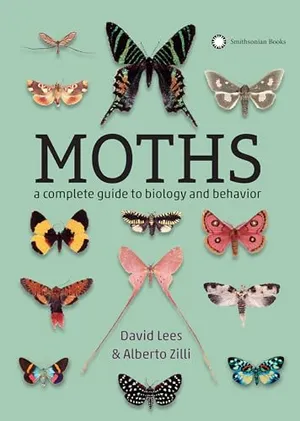The Bizarre Dining Habits of Moths
“Blood, sweat and tears” is not only an idiom for hard work—it’s also what’s on the menu for moths
:focal(320x215:321x216)/https://tf-cmsv2-smithsonianmag-media.s3.amazonaws.com/filer_public/f6/48/f648cea5-1207-411e-8f38-28ac84c00d89/convolvulus_hawk-moth_-_free_to_use_-_charles_j_sharp.jpg)
The hawkmoth known as Wallace’s Sphinx (Xanthopan morganii praedicta) is nectar drinking and is known to visit the spectacular flowers of Darwin’s Orchid (Angraecum sesquipedale) in the Madagascan rainforest.
These flowers are extraordinary. In 1862, in his treatise on the pollination of orchids, Charles Darwin himself thought that a hawkmoth might be responsible for the pollination of the 30 cm (12 in) long flowers and famously proclaimed ‘Good Heavens what insect can suck this?’ In 1867, Alfred Russel Wallace stated memorably “One from tropical Africa (Macrosila morganii) [the hawkmoth’s name at that time] is seven inches and a half. A species having a proboscis two or three inches longer could reach the nectar in the largest flowers of Angraecum sesquipedale, whose nectar spurs vary in length from ten to fourteen inches. That such a moth exists in Madagascar may be safely predicted; and naturalists who visit that island should search for it with as much confidence as Astronomers searched for the planet Neptune, - and I venture to predict they will be equally successful!” It was not until 1903 though that Karl Jordan and Lionel Walter Rothschild actually described a population of that moth from Madagascar. Thus, as dramatically as his quote, Wallace had predicted the existence of this exact species of moth 36 years before its discovery to science, as originally envisaged by Darwin.
In 1992, a pollen mass of the orchid was found adhering to the moth’s proboscis for the first time by Lutz Wasserthal. In 1997, he managed to photograph the pollination event by caging out moths and flowers in Madagascar. Then in 2004, after staking out a flower of A. sesquipedale for three nights in a row, Philip DeVries finally was filmed observing a Wallace’s sphinx visiting an orchid in the wild, thus proving the theory that had been proposed by Wallace 137 years earlier. The moth’s proboscis is 14.5–24 cm (5.7–9½ in) long. However, it has been known for a long time that there is another hawkmoth in Madagascar, Coelonia solani, which exhibits a similar range of proboscis lengths. Is it a competitor and the result of a race for the longest tongue that can suck the last drop of this orchid’s nectar? Apparently not! Actually C. solani seems to avoid A. sesquipedale and instead, offered the choice, likes to feed from the most closely related orchid, A. sororium. Along with other plants, notably in the families Rubiaceae, Caprifoliaceae and Solanaceae, Angraecum orchids are thus another group of ‘sphingophilous’ (sphingid-pollinated) plants. However, in the wild the story is doubtless more complicated, and the two Madagascan hawkmoths with giant proboscides may indeed compete. Furthermore these moths are not limited to feeding on orchids. It has been discovered by botanist David Baum that both species are the most important pollinators of Adansonia perrieri, a baobab species found in western Madagascar.
These hawkmoths have a fascinating behaviour. They have a technique called swing-hovering. Swinging from one side to another, they hover at an orchid with the tip of their proboscis inserted into the flower spur, allowing them to be wary of predators. Remarkably, lemurs have learned to snatch the moths when these are nectaring on baobab flowers. When servicing the long-tubed Angraecum orchids, the proboscis is usually long enough to get at the nectar right at the bottom of the tube, and allow the plant to glue the pollen package on to the base of the proboscis ready to be transferred to the stigma. Angraecum species with longer nectar tubes are increasingly reliant on such a powerful disperser as Xanthopan morganii praedicta, and avoid less dependable pollinators. This can work because the longer the tube, the larger winged and more powerful a flyer the moth must be, due to a strong biometric correlation between wing size and proboscis length. Sometimes the spur of an orchid can be considerably longer than the known range of proboscis lengths of any known giant hawkmoth in Madagascar, as in A. longicalcar, which has a 30–40 cm long nectar tube. This has encouraged speculation among zoologists about a now extinct pollinator! Perplexingly, camera traps placed by botanists around the tiny remaining population of this critically endangered plant have failed to find any visitations. Here is an example of an exquisite orchid in an evolutionary dead end in Madagascar for which we have not even observed its moth pollinator, if it still survives.
Moths: A Complete Guide to Biology and Behavior
Moths are a crucial insect group encompassing more than 160,000 species, and they are among the most ancient of Earth's inhabitants, with some fossils believed to be 190 million years old. This richly illustrated guide to their biology, evolution, and history demonstrates the incredible diversity of these winged insects
Madagascar is the setting for another really remarkable moth story. The world’s first bird-‘eating’ (drinking) moth was discovered in February 2004 by a team of ornithologists (led by Roland Hilgartner) who were studying sleeping birds in the forest of Kirindy. Large moths were photographed clearly feeding on both the Madagascar Magpie Robin and, in December 2005, on the Common Newtonia. The moths fed at night for up to 30 minutes, without either bird batting an eyelid. With closer observation it was seen that the moth inserted its proboscis under the closed lids of the bird’s eye. Hilgartner managed to catch a specimen and send it to one of the authors (DCL) for identification. The moth proved to be a male of Hemiceratoides hieroglyphica (Erebidae) and close examination of the proboscis revealed the tip to be forked and have vicious backward-pointing barbs and spines that latch between the membranes of the bird’s eye, apparently to suck salts from the tears.
This was the first known observation of moth attraction to eyes (opthalmotropy) in Madagascar, where hoofed mammals are naturally absent. Ungulates are the usual hosts of tear-drinking (lacryphagous) moths, of which many examples are known around the globe, notably in the families Geometridae, Erebidae, Notodontidae Crambidae and Drepanidae. Some species have also been observed frequenting eyes of other mammals such as elephants and, not least, man. In Africa, such eyefrequenting moths repeatedly visit and may sometimes even benefit by digesting leucocytes from pus that presumably results from infection by bacteria or viruses! Hoofed animals are relatively defenceless against these nocturnal visitations, whereas primates can easily brush off irritating insects. Perhaps birds, which are also fairly defenceless, may prove to be more commonly attacked than previously thought. Indeed another such attack was filmed in Brazil of the erebid Gorgone macarea on a Black-Chinned Antbird. There is another Hemiceratoides, currently classified as a subspecies of H. hieroglyphica (vadoni), which is known from eastern Madagascar, and others in Africa, so tear feeding observations are needed in these moths, too. Finally, there is a potential vampire moth species in Madagascar, the erebid Calyptra triobliqua, which also has a viciously barbed proboscis. But what it feeds on is currently unknown! There is much still to discover in a place as strange as Madagascar, and elsewhere!
The discovery in 1980 by Häns Banziger of the first known case of vampirism in a moth, Calyptra eustrigata, was astonishing. Some 18 species of Calyptra are now known and include about 10 capable of piercing the skin of mammals to feed on blood. Some moths will even feed on humans, including the Asian species C. bicolor, C. fasciata and C. ophideroides. There is one vampire moth species that occurs in Europe, C. thalictri, though somewhat reassuringly for Europeans, it has only been seen blood-feeding under experimental conditions by Jennifer Zaspel and Vladimir Kononenko in the Russian Far East. Hans Bänziger recounts how he was driving along in a taxi in Thailand and a moth flew in the open window and attacked his chauffeur. In order to feed on blood, a Calyptra moth moves its proboscis back and forth and drills it into sometimes thick skin. It then more emphatically rocks its head to ram it in further, before hooks on the moth’s proboscis latch it in position. Then it sucks the blood, although it is not known if any anticoagulants are used. The evolutionary sequence is thought to be from piercing fruit to animal skin as the moths developed a taste for blood.
/https://tf-cmsv2-smithsonianmag-media.s3.amazonaws.com/filer_public/3d/90/3d9060ee-69e2-4676-ba35-b93ed028666e/proboscis_tip_of_a_vampire_moth_the_trustees_of_the_natural_history_museum_london.jpg)
Many tropical moths do in fact pierce fruits to suck their juices. With strong tearing hooks on the proboscis, many beautiful large moths in the erebid genera Eudocima and Phyllodes (as well as Calyptra) can easily penetrate through the thick skin of fruits such as orange, pineapple or pomegranate. Some of these moths turn out to be major pests in orchards, as the wounds they make in the skins leave the fruits exposed to fungal and bacterial infections. There are, however, several less specialized moths that feed on fruits whenever they are given the opportunity. They usually visit soft-skinned or fully ripened, wounded fruits but a few species can pierce skins as hard as those of rose hips. One freezing Christmas night in the snowy environment of the Apennine Mountains, AZ was quite amazed to witness aggregations of Conistra moths frantically piercing the berries of a rose bush.
Feeding on tears of sleeping birds or the blood of mammals is astonishing enough. However, since the dawn of their evolution, adult moths have been incessantly exploring new food sources incessantly and much remains to be discovered. In 1976 North American lepidopterist Mogens C. Nielsen found a hawkmoth, Sphinx luscitiosa, drinking the liquids of a decaying fish with its proboscis deeply inserted through the fish’s skin. He also collated unusual records of other hawkmoths that had occasionally been spotted banqueting on fish, carcasses or dung. Jeremy D. Holloway recalls that in Borneo, geometrids of the genus Zythos have been attracted with carrion-baited traps. Quite long is also the list of species which have been seen drinking at animal wounds, exudates or even human sweat.
AZ once observed during daytime a swarm of normally nocturnal Light Brocade moths (Lacanobia w-latinum) around a black poplar tree. The tree was infested with Poplar Spiral Gall aphids (Pemphigus spyrothecae) which make the leaf stalks (petioles) swell and coil to form tightly spiralled galls protecting the bugs. Remarkably, the moths were frantically inserting their proboscides into the thin passageways left at the centre of these whorls to drink the bugs’ honeydew.
Natural selection has led to some incredible adaptations, not only in mouthparts but also in lifestyles.Read more in Moths, which is available from Smithsonian Books. Visit Smithsonian Books’ website to learn more about its publications and a full list of titles.
Excerpt from Moths: A Complete Guide to Biology and Behavior © The Trustees of the Natural History Museum, London 2019
A Note to our Readers
Smithsonian magazine participates in affiliate link advertising programs. If you purchase an item through these links, we receive a commission.



